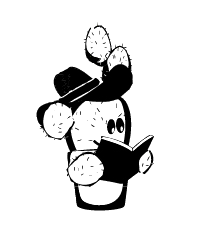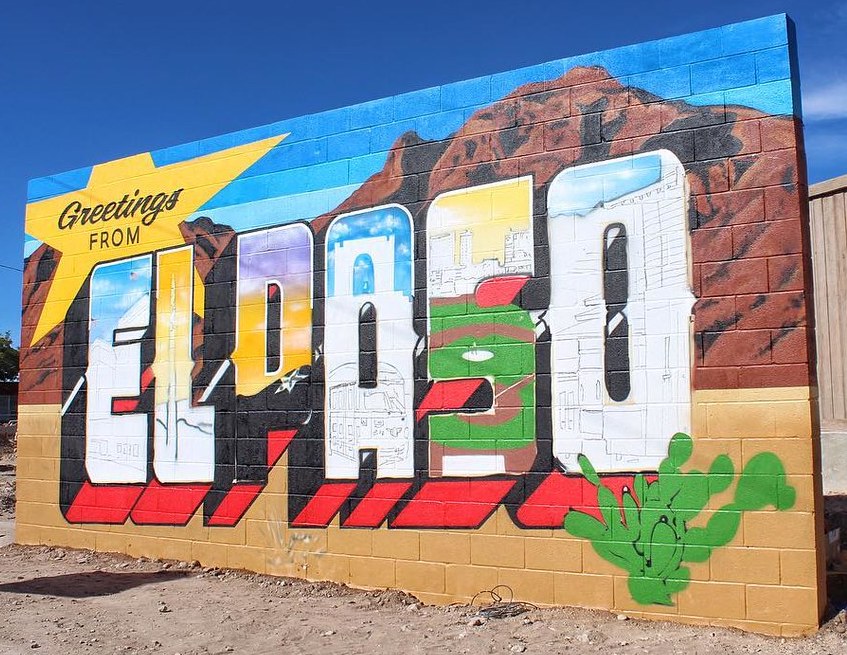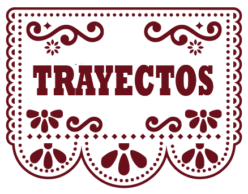 Los números en la ciudad de El Paso
Los números en la ciudad de El Paso
En la sección anterior, hablamos de unos murales en la ciudad texana de El Paso. Esta ciudad tiene una herencia hispana muy importante. Ahora aprendemos algunos números sobre esta ciudad. ¿Cómo decimos estos números?
Have a look at the following numbers, and write down what you notice about them. For example, how do we say 1,000? How do we form numbers in the hundreds? Do we use “and” in numbers such as a hundred and two? Do we use a comma, like in English? Let’s see…

El Paso tiene aproximadamente 302 (trescientos dos) días de sol anualmente por su clima desértico. En el verano, la temperatura es de más de 100°F [cien grados farenheit]). En esta ciudad, viven 683.577 [seiscientos ochenta y tres mil quinientos setenta y siete personas].
El Camino Real de Tierra Adentro fue (was) una ruta de comercio entre la Ciudad de México y San Juan Pueblo en Nuevo México entre los años 1598 (mil quinientos noventa y ocho) y 1882 (mil ochocientos ochenta y dos).
As you can see in this short text on the city of El Paso, numbers in Spanish are similar to and different from English. What have you noticed? What are the similarities? What are the differences? Here we offer you some rules that can help you use complex numbers in Spanish:
- Unlike English, there is not an “y” directly after the number one hundred (ciento in combination with other numbers). Ejemplos: 101 (ciento uno), 133 (ciento treinta y tres).
- Ciento is used in combination with numbers from 1 to 99: ciento uno, ciento dos, ciento ochenta, and so on. Cien is used when counting and before numbers greater than 100: cien mil (100.000), cien millones (100.000.000).
- Like we saw in Módulo introductorio, numbers agree in gender and number with the noun they modify: doscientos cuadernos, trescientas computadoras.
- The word mil does not have a plural form in counting. However, the word millón has the plural form millones. When followed directly by a noun, millón (dos millones, and so on) must be followed by de.
$3000 –> tres mil dólares
$20.000.000 –> veinte millones de habitantes
- When expressing dates, years are never written with a period or a comma. Also, the numbers 200-900 will be masculine and plural to agree with the implied or stated masculine plural noun años. Years must be spelled out (1992: mil novecientos noventa y dos) rather than broken into two-digit groups (nineteen ninety-two)
2019 –> dos mil diecinueve
1876 –> mil ochocientos setenta y seis
Los números de cien al millón
| 100 cien (ciento + número) | 700 setecientos(as) |
| 200 doscientos(as) | 800 ochocientos(as) |
| 300 trescientos(as) | 900 novecientos(as) |
| 400 cuatrocientos(as) | 1.000 mil |
| 500 quinientos(as) | 1.000.000 un millón |
| 600 seiscientos(as) | 2.000.000 dos millones |
![]() El cactus viajero
El cactus viajero
In many parts of the Spanish-speaking world, a period is used when English uses a comma, and a comma is used to indicate the decimal: $1.600; $1.000.000; 5,4%.
Ahora usamos nuestros números. ¡A trabajar! Actividad 3-12. ¿Cuánto cuesta ser estudiante? Remember Mariana? We met her in Módulo introductorio. She has decided to attend your university, and she needs help preparing her budget. You want to give her an idea of the prices of things in your town. Paso 1. Tell Mariana how much the following things cost. Prepara los número en español para su presupuesto (budget). 1. Alquilar un apartamento por un mes. ¿Tienen números similares? ¿Quién de ustedes tiene un presupuesto más barato (cheaper)? En esta actividad trabajas con cuatro compañer@s. Otro artista importante de El Paso es Manuel Gregorio Acosta. And in this activity, you and your classmates will create a brochure in Spanish to advertise an auction of some of Acosta’s paintings. Paso 1. Watch this video (http://bit.ly/Video3-4Trayectos) about an auction of Acosta’s paintings. Each member of the group will be responsible for one painting. Watch the video and fill out the following table. Paso 2. You want to attract Spanish speakers in Texas to the auction. Create a script for a video for this audience similar to the one you saw in English. Your group will present the script to the rest of the class. Include the following: Information about each painting (pintura): Include the information you wrote in Paso 1. ¡Bienvenidos, amigos de El Paso! Los invitamos a una subasta de las pinturas del artista mexicano-americano Manuel Gregorio Acosta. Este artista… Paso 3. Optional: Record your script. Each person in the group should participate equally. You can add music too! En esta actividad trabajas con cuatro compañer@s. You are going to find out how much it costs for a university student to study in your state. You and your partners will choose four different universities in the state. One of them should be your own institution. Paso 1. Choose the institutions on which you want to focus. Distribute them among the members of the group. Paso 2. Visit the universities’ pages, and fill out the following table. Write the cost of each of the categories given. Each person should be responsible for one institution. Paso 3. Share the results of your research with your partners. ¡Usa el español! ¿Cuánto necesita un@ estudiante en cada universidad? ¿Qué universidad es la más barata (cheapest)? ¿Es tu universidad? ¿Cuál es la más cara? Como vimos (we saw) en el Módulo introductorio, uno de los grupos importantes del mundo hispanohablante son los afrodescendientes. En esta actividad, usas tus nuevos números para aprender más sobre estas personas. Trabajas con tres compañer@s. Para buscar información, necesitas visitar estas páginas: Paso 1. ¿Quiénes son los afrodescendientes? ¿Qué otros nombres reciben? ¿Cuál es la población total? Paso 2. You and your group will focus on four countries. Each member will choose one of the four Spanish-speaking countries in the table assigned to your group, and will gather information about the AfroLatinx population. Each person will fill out the table with the information for which they are responsible. Grupo 1: Grupo 2: Grupo 3: Grupo 4: Paso 3. Share the results of your research with your partners. ¡Usa el español! ¿Qué similitudes y diferencias hay entre los países? What surprised you about these groups? ![]() ¡Manos a la obra!
¡Manos a la obra!
2. Alquilar un coche por dos semanas.
3. El costo de un galón de gasolina.
4. El costo de 5 galones de gasolina a usar durante una semana.
5. La matrícula de un curso de cuatro créditos.
6. Una computadora portátil de una buena marca (brand).
7. La factura (bill) mensual del gas y de la electricidad.
8. El costo total de la cuenta (bill) semanal del supermercado para dos personas.
9. Una cena en tu restaurante favorito.
10. El libro de una de tus clases (por ejemplo, historia, estadística, etc.)![]() Paso 2. Compara tus números con un@ compañer@.
Paso 2. Compara tus números con un@ compañer@.
![]() Actividad 3-13. Subasta (Auction) de pinturas de Manuel Gregorio Acosta
Actividad 3-13. Subasta (Auction) de pinturas de Manuel Gregorio Acosta
Pintura
Número 1
Número 2
Número 3
Número 4
Nombre
Dimensiones (en pulgadas [inches])
Valor
Oferta [bid] inicial
![]() Actividad 3-14. Investigación: ¿Es caro estudiar en tu estado?
Actividad 3-14. Investigación: ¿Es caro estudiar en tu estado?
Universidades
Universidad 1
Universidad 2
Universidad 3
Universidad 4
Matrícula (Tuition and fees)
Libros y otros materiales
Habitación y comidas
Gastos personales
Viajes (Traveling)
Total
![]() Actividad 3-15. Los afrodescendientes
Actividad 3-15. Los afrodescendientes
Países
Colombia
Honduras
Cuba
México
Localización del país (continente y fronteras)
Población total del país
Número de afrodescendientes
Datos históricos/culturales importantes
Nombres en el país
Países
Venezuela
Guatemala
República Dominicana
Estados Unidos
Localización del país (continente y fronteras)
Población total del país
Número de afrodescendientes
Datos históricos/culturales importantes
Nombres en el país
Países
Perú
Nicaragua
Puerto Rico
México
Localización del país (continente y fronteras)
Población total del país
Número de afrodescendientes
Datos históricos/culturales importantes
Nombres en el país
Países
Uruguay
Costa Rica
Panamá
Estados Unidos
Localización del país (continente y fronteras)
Población total del país
Número de afrodescendientes
Datos históricos/culturales importantes
Nombres en el país
Click on the following button to continue using your new numbers.
Ahora dejamos (we leave) nuestras ciudades por un momento y aprendemos sobre España. Vamos a


